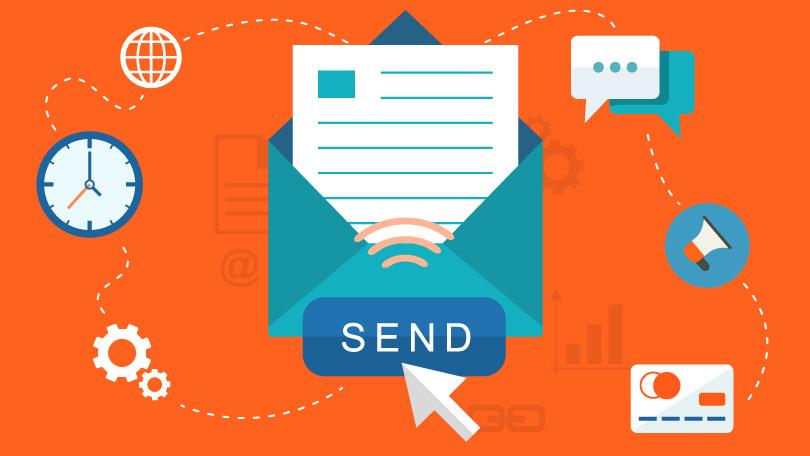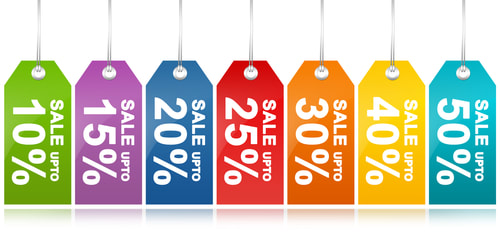Here are some of the ecommerce marketing mistakes your brand could be making (without even knowing it): #1 An Inefficient Website With Bad Mobile Optimization It’s more important than ever to ensure your website functions seamlessly. Otherwise, customers get distracted or frustrated and move on to the next thing. Having a beautifully designed, professional website that attracts and keeps customers is one of the best ecommerce marketing plans you can have. When it comes to mobile shopping, this sentiment goes double! Be sure your website has proper mobile optimization. The user experience of desktop and mobile shopping needs to be attractive, but also a well-oiled machine. From good SEO and product descriptions to excellent customer service, many of the ecommerce marketing mistakes listed below can help you achieve that. However, it starts with hiring the right website builders and integrating the right CMS platform for your business. #2 Forgetting Lead Capturing Potential customers might not always make an immediate purchase. That’s why it’s imperative to create a good lead capturing system. A pop-up for email signups (with a tempting discount) is one great way to turn those potential customers into first time buyers. You can also capture leads through chatbots and social media channels. Leadpages, ActiveCampaign and Getsitecontrol are just some of the powerful lead capturing and lead generation tools you have to work with. #3 Poor SEO and Product Descriptions It’s important to have an attractive website. This much is true. However, it’s also critical to have good SEO that draws customers to the website in the first place. An SEO plan using targeted keywords, accurate product descriptions, and well-written copy will help customers find your items with a simple search and give them the unique details of the item. You can hire someone internally to do so, but it’s more fruitful to hire an agency like Cennos that is already familiar with the proper use of long-tail keywords and in tune with more up-to-date trends and styles so your product descriptions are both search engine optimized, accurate, and appealing. #4 Ignoring Reviews and Testimonials With online shopping, having reviews and testimonials is more important than ever. Customers can’t touch and feel in person, so hearing or reading what previous buyers thought of the product is crucial. When building a website, be sure to make room for reviews and testimonials. Customers are more confident to purchase a product if they can read the social proof and what other customers think of it. It offers a level of transparency and boosts conversion rates. Having social proof on your website is just the first step. It can come in other ways too. Influencers can post their reviews across social media. Remember: It’s about more than a single product review. It’s also about your brand image. #5 Skipping on a Social Media Strategy Speaking of using influencers for social proof, let’s discuss the importance of a social media strategy. Promoting items and your brand online is a must in today’s age. If you aren’t taking advantage of social media platforms to engage with customers, you’re really missing a huge piece of the puzzle. However, it’s wise to come up with a social media strategy. For starters, it helps to know what social apps your target audience prefers. Then, you can create social media ads that show up in their algorithms. Again, this is where hiring a professional can help. Skilled social media strategists can ensure your ads are targeted correctly with the proper keywords, all while following each social platform's strict ad rules and regulations. #6 Not Focusing on Your Target Audience Another ecommerce marketing mistake that could be costing you? Not understanding your target audience. Or – and let’s say you do – simply not focusing on them. Driving traffic to your website through SEO and reviews helps, but it is also essential to hone in on your target audience directly. Sadly, many businesses cast a wider net with the intention of attracting a wider audience. But it pays to be as specific as possible! Research your target audience by creating a buyer persona so you can better understand what they are searching for in a product or service. Photo by Myriam Jessier on Unsplash
0 Comments
 You’ve built your email list to a point where it’s time to automate. But how do you do it? The nuts and bolts of process and procedure are great, but you need to start with a strategy. Simply sending the same message to every customer, or potential customer, on your list isn’t enough. As nice as one-size-fits-all is in theory, in practicality, it’s not very effective. So what does work? Define and Segment Your Audience If you want to tailor your approach, you’re going to start by thinking about what separates those on your list. A customer that made a purchase last week is different than a customer that made a purchase last year is different from a potential customer who hasn’t made a purchase at all. Once you’ve created a few segments, you can begin to tailor your outreach approach and to set up automated triggers for email outreach. For instance, if your segment is those who’ve made a purchase between 10 and 90 days ago, you might consider sending an offer for free shipping or a discount code. Collect Data During Sign Up They got on your list somehow. Presumably most had to fil out a form and give you their email address. But that’s not the only thing you can ask for. Here are other pieces of information that you might find useful:
A/B Testing and Analytics Are Your Friend Dive into all that data that’s right at your fingertips and begin by texting different email strategies to see which get you the best open, click-thorough, and purchase stats. Don’t hesitate to test in parallel, either. Got a message going out? Create two versions to determine things like the best subject lines, whether emojis help or hurt, or whether it makes a difference if the email comes from a generic or personal email address. Once you’ve sent those parallel messages, take a look at the stats and use that to build and refine your strategy. In a world that’s ever-changing, more and more quickly, this isn’t a one and done prospect. Revisit your assumptions and test again. Continually be building your strategy and pushing back against what you think you know. What worked in 2019 probably isn’t the same as what will work in 2022. Create Automated Message Flows Once you’ve got a good handle on what works on whom, it’s time to actually devise your email strategy. You can start by creating workflows – series of emails that push a customer to your desired outcome. What might that look like? For a new customer who’s just joined you list, it’s a welcome series of 2-3 emails that establish your brand/ mission and invite them along on your journey. For someone who’s abandoned a cart, it’s a series of email tempting them to return to finish their purchase. Other ideas include a birthday series, an order and shipping series, purchase follow-up, and reactivation for customers who’ve gone quiet. And, of course, you should be tailoring these workflows to your specific business and audiences, and you should be testing various messages and strategies within your emails. The result? Better ROI. Higher conversion rates mean more business and really, that’s the whole goal. In a pleasant turn of events, sophisticated consumers are no longer automatically averse to email solicitations. Perhaps the years have instilled patience and discretion, leaving them more open to opening an email even if it isn’t from a colleague, romantic interest, or their mom. That said, there is a method of madness to employ when crafting a direct mail campaign strategy – or really, any form of communication between your business and a current or prospective customer. And it’s something few really think about. Let’s start this with an illustration. When you open your email app and peruse the cascading list of incoming mails, what’s the first thing that catches your eye? Chances are it’s a sender address that is recognizable. This is where we start with productive, successful marketing. A “sent from” name can be an automatic invitation to the trash bin. Consider this one: It goes without saying that an email with this sender name isn’t exactly inviting. And truthfully, it’s more likely to come from a larger company with a robust list of email accounts linked to their domains. Even then, with the glut of spam out there, it’s not likely to be read.
Do you have a single email account linked to your domain name, with your actual name as the prefix? That’s not a winning strategy. Add a few more. Even dedicated customers may not react to an email coming from a name they don’t recognize. When it comes to promoting your business, email continues to be one of the most important ways to reach customers and increase sales. Although it may seem that social media is catching up quickly, the numbers show that email marketing continues to be more effective for businesses to communicate with their customers.
A recent survey found that only 41 percent of people, and only 30 percent of Americans, trust social media. Four in ten people have deleted a social media account in the past year. Conversely, email use continues to grow, with a whopping 3.8 email users in 2018. That number is set to grow to 4.4 billion by 2023. Let’s explore some of the reasons why your email list is still the most effective way to reach customers in 2019. It’s Cost Effective The average business owner reported a return on investment of $42 for every $1 spent on email marketing in 2019. That’s up from $38 for every $1 spent in 2018. If you focus on fine-tuning your message and determining what’s most effective for your audience, that number could increase exponentially. It Requires Permission Unlike Facebook, where people are bombarded with ads from companies they’ve never heard of, people who choose to receive your emails do so willingly. They’ve already expressed an interest in what your business has to offer. Requiring a double opt-in, or adding an extra step for customers to receive your emails, narrows it down even further. Research has shown that requiring a double opt-in can increase ROI by an average of 13%. Note to ecommerce vendors: It’s never been a more exciting time to sell things.
As new and riveting internet-based platforms emerge to make the process easier, faster, and more fruitful, there’s one that’s been around a long time and is still arguably the backbone of any business. Email. Email marketing morphs a tool invented for personal conversations into a dynamic, effective platform for pitching products and services to would-be customers who may or may not know of you. Email happens to be the most widely used of all modern communications channels. Estimates say 99 percent of all consumers check theirs on a daily basis. And perhaps it’s a better choice than other advertising-related vehicles for the simple reason that people read their emails with a different expectation than they have when they browse social media, or even watch television. Advertising that interrupts play time is probably less palatable than direct messaging sent to an account people read knowing they are there to receive messaging. If you’ve prioritized your marketing and outreach through social media channels, there’s nothing wrong with that. Just consider the new benefits of an old standby that won’t steer you wrong. Start With a Plan Forming an email marketing strategy is pretty simple and straightforward, but there are must-do’s and must-not-do’s to keep in mind. Start with the most obvious, and develop a targeted customer list. Generating leads is easier with the development of tools like Monster Leads, which integrates marketing functions by collecting, sorting, and storing sales leads. A service like this allows you to revisit the email marketing function without having to restructure and search for new targets. Before you stress over being “that guy” sending a ton of unwanted mail, relax. Even if one-quarter of your messages are opened, that’s a significant reach. Another way to test the waters for oversaturation is to select a sub-group of customers you feel good about, and set them up for more frequent sends, while limiting the rest of the list to occasional messaging. Once you have a target audience, think creatively by envisioning what you might respond to favorably. Develop eye-catching graphics that are easy to read and understand. Refine your wording to be brief, engaging, and (most importantly) urgent enough to prompt consideration. Tell the truth. As a new ecommerce vendor, or even a somewhat seasoned hat, were you in awe of the way you have picked up the essentials of running a business that’s essentially global in some respects? Paying attention to strategies such as marketing, budgeting, and developing ways to maximize revenues with a minimum of investment?
It’s a constant challenge, and as you shape your philosophy and brand, you’ll settle on a policy, if only internally, for striking a balance between luring customers with discounts and giving away the store. The concept of discounting involves variables, for sure. The brick-and-mortar “sale” is far easier to generate on the fly, while an online shop that necessitates a physical and time-centered distance between you and your clientele involves far better planning. It also begs the question you may not want to answer. Are you willing to take daunting risks just to gain customers? Mid- to large-size businesses operate in a universe you can barely see through a telescope. They focus on margins, set-asides, long-term marketing plans, and ROIs at a degree you may realize one day. In the interim, a wholly different strategy applies to the average ecommerce biz. It’s 2018: we get a lot of e-mails. Most of them are just sent to spam or deleted without opening. How can you make sure that your e-mails stand out against all the noise?
E-mail copywriting takes time, effort, and creativity— and can often be a daunting task. Let’s simplify the process of designing an awesome e-mail. It’s vital to keep in mind is what your customers will be seeing. |
Archives
October 2021
Categories
All
|









